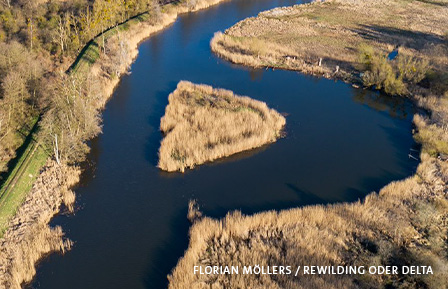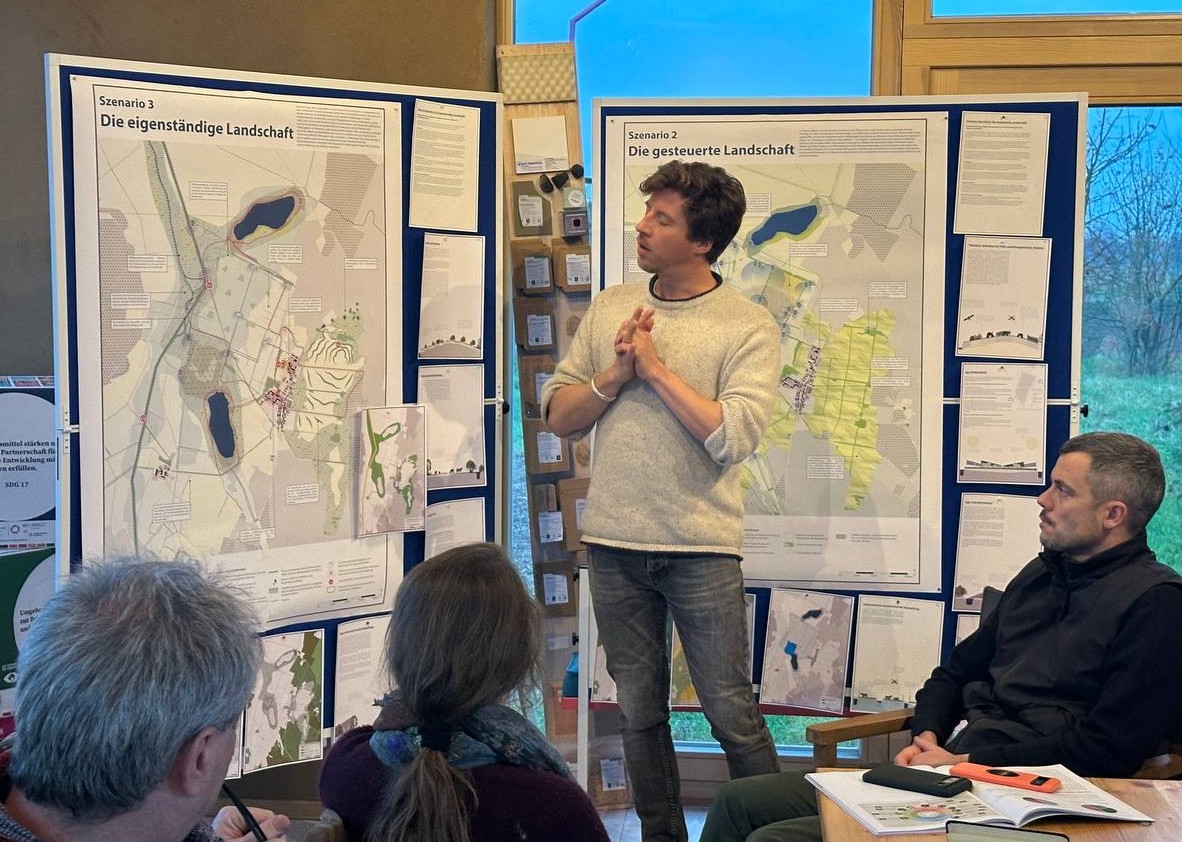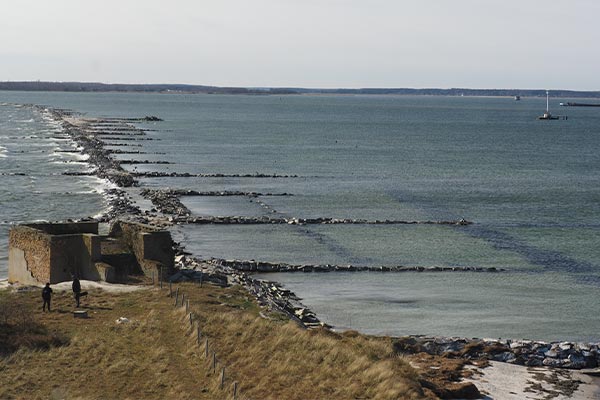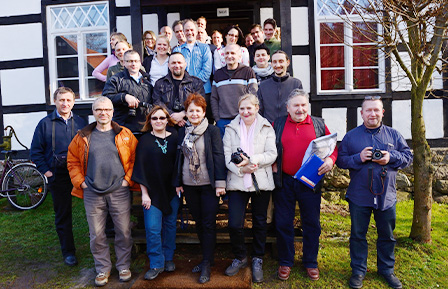The Rewilding Oder Delta landscape covers an area of 450,000 hectares, of which the open waters of the Stettin Lagoon make up 70,000 hectares. Our core work areas consist of the Peene River and the Ueckermünder Heath, the Ina and the Gowienica Rivers, the surrounding forest regions of Puszcza Goleniowska, and the open landscapes of the Stettin Lagoon. We are currently extending our activities to the island of Usedom, the Swine Delta, and the Kamieński Lagoon with the Rozwarowo Marshes.
Supported by
The Oder Delta is characterised by a rich mosaic of landscapes. Its numerous lowland rivers create a natural floodplain with extensive areas of peatland, which are accompanied by forests, fields and sandy dunes. The diversity of these habitats is critical to the water balance of the entire region.
As is the case with most European rivers, local waterways have been extensively reengineered, with many barriers and a lack of natural features. Against the backdrop of a changing climate, we face the challenge of adapting the rivers to meet societal and environmental needs.
What we do

Supported by Baltic Sea Conservation Foundation and European Outdoor Conservation Association, we are working to restore the natural morphology of the Ina River, the Oder River tributary, and recreate spawning areas for migrating fish. Through close collaboration with landowners, we are also aiming to extend protected areas. Thanks to the involvement of the local community and volunteers, we run river clean-ups and tree-planting activities. All these measures reduce pollution by boosting the self-cleaning capabilities of the river while simultaneously improving the status of endangered habitats and species, like the Baltic sturgeon, Atlantic salmon and river water-crowfoot.

Together with NABU and Ostseestiftung, we are restoring a meander that had previously been straightened for navigation on the Uecker River. This resulted in reduced flow and intensified natural sedimentation. We plan to address these issues by restoring the silted-up old meander, which will enable the development of a structurally diverse, near-natural riverbed. This intervention is supported by funding from the Deutsche Postcode Lotterie.
In collaboration with our partner, Friends of the Ina and Gowienia Rivers Association, we have filled many man-made ditches with gravel along the Gowienica River. This way, both the water coming from the spring basin and the rainwater stored by surrounding meadows can again slowly feed the river and increase its drought resilience.

We help municipalities and land users adapt to climate change, extreme weather events, and improve water security. Our experts provide technical advice and guidance on accessing funding to support the recovery of freshwater ecosystems. By helping decision-makers create balanced and sustainable waterscapes, our team combines nature conservation with fostering opportunities for local economic growth and community well-being. Current actions are happening in the scope of Modellvorhaben der Raumordnung (MORO) „Grenzüberschreitende Synergien von Raumordnung und Wasserwirtschaft im Einzugsgebiet der Oder“ funded by Bundesministerium für Wohnen, Stadtentwicklung und Bauwesen.
The mosaic landscape of the Oder Delta – characterised by peatlands, rivers, floodplains, grasslands, beech and pine forests – is home to a wide array of species, creating a fascinating biodiversity hotspot. Species that had been locally extinct for decades are now experiencing a comeback thanks to conservation efforts.
Beavers thrive in the rivers of the Oder Delta and shape habitats for endangered wetland species with their ecosystem engineering skills. Flooded woodlands in the delta hosts the highest density of white-tailed eagle breeding pairs in Europe. Wolves roam the forests and help to control populations of herbivores, which contribute to the mosaic character of the landscape through their grazing. Elk, bison and lynx from Poland are migrating westward and expanding their distribution range.
A landscape shared by humans and wildlife
While populations of the above-mentioned species are on the rise thanks to legal protection and/or reduced hunting pressure, the main threat remains the construction of human infrastructure in the landscape, leading to habitat fragmentation preventing wildlife dispersal and genetic exchange between populations. We are, therefore, looking for ways to reconcile human land use and landscape connectivity.
What we do

As a part of the research project Rewild_DE – and in cooperation with the German Institute for Integrative Biodiversity Research (iDiv) – we are using camera traps to gather information about the composition of the delta’s mammal community and look for evidence for the presence of rare or returning species, such as wild cat and elk. Based on our camera trap data, we have identified wildlife corridors and are advocating the creation of wildlife crossings, which would make obstacles in the landscape navigable for wildlife.
We closely collaborate with the West Pomeranian Nature Society (ZTP), supporting their work on bison, Eurasian lynx and elk and learning about human-wildlife coexistence strategies to prepare for the comeback of these species in Germany.
About 13% of the world’s marine habitats are classified as unaffected or at low risk of negative impacts from human activities, yet only 4.9% are recognised as protected areas. This is why our marine rewilding efforts aim to support the natural regeneration of marine habitats through the establishment of no-take zones, the cessation of destructive activities in marine protected areas, and the active reintroduction and restoration of marine species and habitats in the southern Baltic Sea.
Marine ecosystem services
With their ability to absorb and store carbon, marine and coastal habitats such as seagrass meadows and salt marshes are becoming increasingly important as nature-based climate solutions. Their protection and restoration also help to enhance water quality, prevent coastal erosion, and improve biodiversity and fisheries production. Healthy seas and coastal areas provide multiple benefits and are critical to economic productivity and human wellbeing:
COASTAL DEFENCE
protection of land from flooding and storm surges
CULTURAL VALUE
providing tourism and recreation
FOOD PROVISION
feeding and nursery grounds for (shell)fish
CLIMATE REGULATION
global temeratures and wind patterns
CARBON SINK
sequestration of atmospheric carbon
The state of the Baltic
Like other oceans and coasts across the world, the Baltic Sea is in a poor ecological condition due to severe overexploitation. The Pomeranian Bay and Greifswalder Bodden’s ecosystems are degraded by overfishing, eutrophication and pollution, resulting in significantly reduced resilience to cumulative pressures like climate change. Marine rewilding activities help to mitigate the scale and impact of climate change, with ecological, social and economic challenges that come with it.
What we do

Beach nesting birds like the little tern and ringed plover are regionally threatened due to mass tourism – particularly beach tourists. This is why we are working to recreate undisturbed breeding sites on Ruden Island using sandy sediment provided by the German Baltic Sea Waterways and Shipping Authority. Thanks to the support of Deutsche Postcode Lotterie, we are currently mapping protected biotopes like reefs and seagrass beds to prepare the sand habitats.
A nature-based economy is where the inter-related production and consumption of goods and services promote nature conservation and regeneration. Healthier and more diverse ecosystems benefit local wildlife-related businesses, support job creation and boost income for local communities.
Following World War II, the region remained largely untouched by industrial development – today, large parts are still undisturbed, unfragmented and sparsely populated, providing ideal conditions for wildlife and natural climate protection. This unique environment offers numerous opportunities to develop a thriving nature-based economy.
As the increased wildlife numbers provide a basis for a distinctive and varied tourism offer, Oder Delta can become one of the best places in Europe for birders but also for our Big 7 – emblematic species of the European natural heritage present in our landscape that include: white-tailed eagle, Baltic sturgeon, grey seal, European bison, elk, wolf and beaver.
What we do
We support enterprises connected with nature guiding, accommodation, transport, gastronomy, wildlife hides, and local produce. We are collaborating with a wide range of stakeholders and members of local communities to create high-quality marketable (wildlife tourism) products and services based on the natural landscape – this, in turn, will help to build engagement with and support for rewilding and the objectives of Rewilding Oder Delta.

Social coherence can be enhanced if local businesses build networks and generate multiplier effects. This is why we are strengthening the Oder Delta Network and nature guide network by offering training and opportunities to connect and exchange.
By establishing a community of like-minded enterprises, we aim to:
- develop a stronger business environment that fosters cooperation instead of competition
- promote the region together with its natural and cultural values
- facilitate partnerships between tourism-related entities to create new tourism offerings and packages.